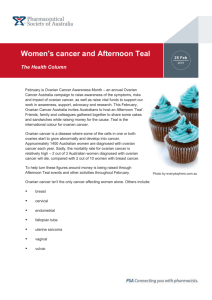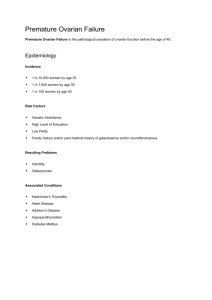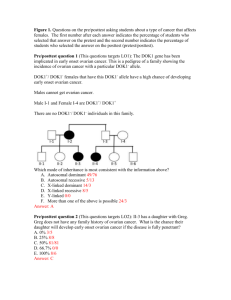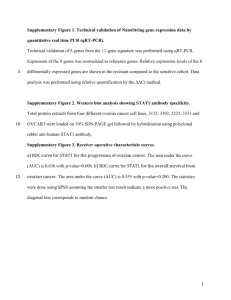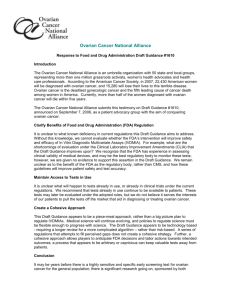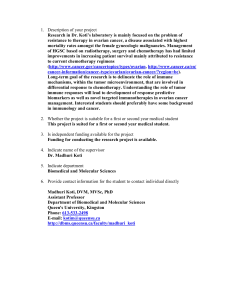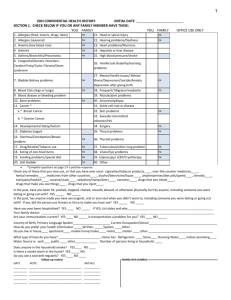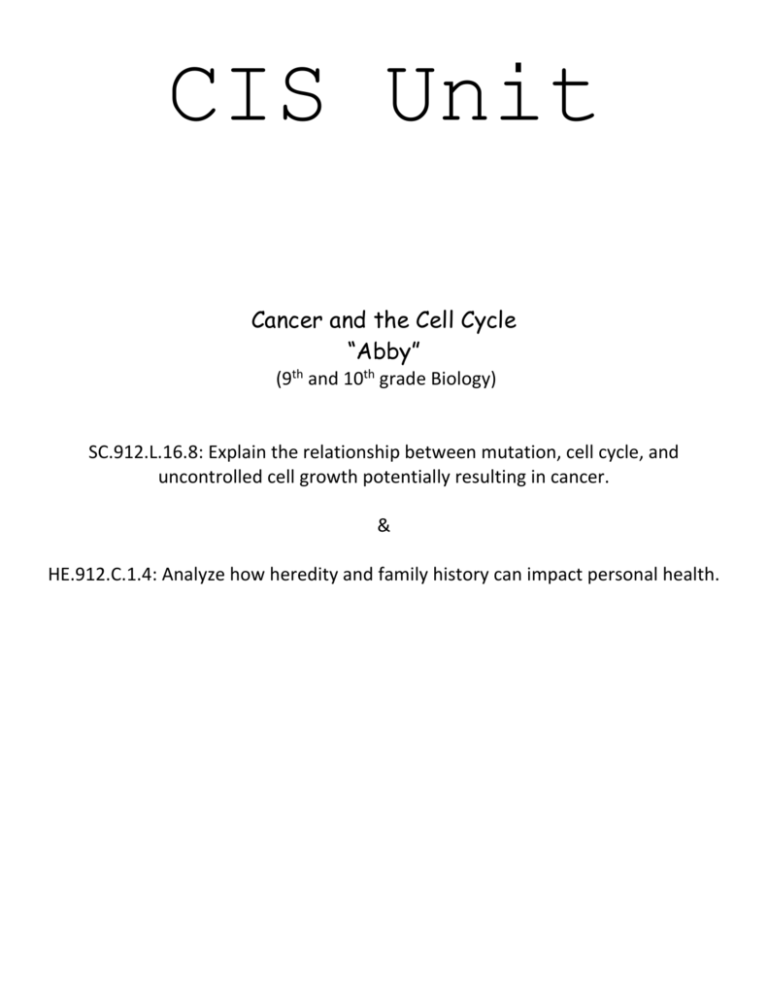
CIS Unit
Cancer and the Cell Cycle
“Abby”
(9th and 10th grade Biology)
SC.912.L.16.8: Explain the relationship between mutation, cell cycle, and
uncontrolled cell growth potentially resulting in cancer.
&
HE.912.C.1.4: Analyze how heredity and family history can impact personal health.
CIS Lesson
Cancer and the Cell Cycle
“Abby”
1. Hook Engage:
Do you know someone personally that has had cancer? (If you do not know someone personally,
think about someone on a TV show or movie that you watched.)
Discuss with a shoulder partner:
What kind of cancer it was?
The medical effects on that person?
The emotional impacts it had?
2. Question #1
Predict what ovarian cancer is and some of the symptoms a person might experience if they have
ovarian cancer.
3.
Pass out article
4. Pre-teach vocabulary
a. Abdomen
b. Gynecologist
c. Sonogram
d. Cyst
e. Compensate
f. Scoured
g.
h.
i.
j.
k.
l.
Uterus
Fallopian tubes
Progenitors
Mutations
Proverbial
Chemotherapy
m.
n.
o.
p.
Proliferate
Hyperplasia
Tumors
Lymphatic
system
5. Text-marking
T = Threat or Harmful
S = Scientific Observation
6. Question #2
Explain what ovarian cancer is and some of the symptoms a person might experience if they have
ovarian cancer.
7. Note-taking
a. Difference between normal cells and cancer cells
b. Risk factors for ovarian cancer
c. Cellular basis for cancer
8. Question #3
In conducting her web search, Abby has landed on your medical information website. Using the
information provided in the readings, construct the informational text that Abby reads while on
your site. Make sure to cite your references as you want your visitors to trust the information
that you are providing. Feel free to introduce additional high quality resources as necessary.
#1 Predict what ovarian cancer is and some of the symptoms a person might experience if
they have ovarian cancer.
#2 Explain what ovarian cancer is and some of the symptoms a person might experience if
they have ovarian cancer.
But I’m Too Young!
A Case Study of Ovarian Cancer
by
Nancy Rice, Department of Biology, Western Kentucky University
Bruno Borsari, Biology Department, Winona State University
Abby was in her Introductory Biology class that morning, listening to a speaker talk about human evolution. Although she
was particularly interested in this topic because it related to the anthropology class she was currently in, she was unable to
pay attention because of the pain in her abdomen. She had been experiencing it for a few weeks, but now it was becoming
unbearable. She began to sweat.
“What’s the matter?” whispered her roommate Kelly, who was sitting next to her. “Are you all right?” “My stomach hurts! I
don’t think I can make it to the end of class. I really think I need to see a doctor.” The tears running down Abby’s cheeks told
Kelly that she was not joking. Kelly grabbed Abby’s book bag and helped her friend get up. They went straight to the campus
health center.
“Well, the fact that you don’t have any fever and that your pain doesn’t appear to be coming from your appendix is good,”
comforted the physician at the health center after checking Abby’s abdomen. “I’m going to give you some medicine to
relieve the pain for right now, but tomorrow I want you to come in to see Dr. Allen, our gynecologist. I would like her to run a
few more tests in order to figure out where your pain is coming from.”
The next day Abby went to see Dr. Allen. During the examination, Dr. Allen felt a mass on Abby’s right ovary while pressing on
her abdomen. Dr. Allen ordered a sonogram.
“Abby, the sonogram shows that you have a growth on your right ovary,” Dr. Allen said. “It is likely a cyst, but we’ll need to do
some more testing to be sure. Many times a cyst will resolve on its own, but since this one is so large, I am going to
recommend that we go ahead and have it surgically removed, along with your right ovary. This should help relieve the pain.
Your remaining ovary will compensate for the one missing by ovulating every month. I would also like to run a blood test to
look for signs of ovarian cancer. While rare at your age, increases in a protein called ca-125, a marker of cancer, will be able
to help us determine if we are dealing with a cyst or cancer.”
Abby was scared. What did all this information mean? She felt overwhelmed, and when she returned to her dorm she broke
down in tears. That night, unable to sleep, Abby scoured the internet trying to find answers to her questions.
Case copyright ©2008 by the National Center for Case Study Teaching in Science.
Originally published August 2008 at http://www.sciencecases.org/ovarian_cancer/handout.asp.
Please see our usage guidelines, which outline our policy concerning permissible reproduction of this work.
940L
What are the risk factors for ovarian cancer?
American Cancer Society, 1180L
http://www.cancer.org/Cancer/OvarianCancer/OverviewGuide/ovarian-canceroverview-what-causes
While we don’t yet know exactly what causes most ovarian cancers, there are
many ideas about this. Some of them come from looking at the things that
change the risk of ovarian cancer. For example, pregnancy and taking birth
control pills both lower the risk of ovarian cancer. Since both of these reduce
the number of times the ovary releases an egg, some researchers think that
there may be a link between the release of eggs and the risk of getting ovarian
cancer.
Also, we know that women who have had their tubes tied (tubal ligation) or who have had their uterus
removed (a hysterectomy) have a lower risk of ovarian cancer. One way to explain this is that some cancercausing substances may enter the body through the vagina and pass through the uterus and fallopian tubes to
reach the ovaries. This would explain why taking out the uterus or blocking the fallopian tubes might reduce
ovarian cancer risk.
Another risk factor is obesity. Very overweight (obese) women seem to have a higher risk of getting ovarian
cancer. A study from the American Cancer Society also found a higher rate of death from ovarian cancer in
women who were overweight. The risk went up by 50% in the heaviest women.
Of course, ovarian cancer can run in families. Your ovarian cancer risk is higher if your mother, sister, or
daughter has (or had) ovarian cancer. The risk gets higher the more relatives you have with ovarian cancer.
Increased risk for ovarian cancer does not have to come from your mother's side of the family -- it can also
come from your father's side.
A risk factor, like those mentioned above, is something that affects a person's chance of getting a disease.
Different cancers have different risk factors. Some risk factors, such as smoking, can be controlled. Others, like
a person's age or race, can't be changed.
But risk factors don't tell us everything. Having a risk factor, or even many risk factors, does not mean that you
will get the disease. And many people who get the disease may not have had any known risk factors. Even if a
woman with ovarian cancer has a risk factor, it is very hard to know what part that risk factor may have played
in the development of the cancer.
Cell Division and Cancer
by Nature Education, 1300L
http://www.nature.com/scitable/topicpage/cell-division-and-cancer-14046590
Cancer cells are cells gone wrong — in other words, they no longer respond to many of the signals that control cellular
growth and death. Cancer cells originate within tissues and, as they grow and divide, they diverge ever further from
normal. Over time, these cells become increasingly resistant to the controls that maintain normal tissue — and as a
result, they divide more rapidly than their progenitor cells and become less dependent on signals from other cells.
How Do Cancer Cells Differ from Normal Cells?
In normal cells, hundreds of genes control the process of cell division. Normal growth requires a balance between the
activity of those genes that promote cell division and those that suppress it. It also relies on the activities of genes that
signal when damaged cells should kill themselves.
Cells become cancerous after mutations accumulate in the various genes that control cell division. According to research
findings from the Cancer Genome Project, most cancer cells possess 60 or more mutations. The challenge for medical
researchers is to identify which of these mutations are responsible for particular kinds of cancer. This process is akin to
searching for the proverbial needle in a haystack, because many of the mutations present in these cells have little to
nothing to do with cancer growth.
Different kinds of cancers have different mutational signatures. However, scientific comparison of multiple tumor types
has revealed that certain genes are mutated in cancer cells more often than in other cells. For instance, growthpromoting genes, or oncogenes which are mutated forms of genes that control cell division, are among those most
commonly mutated in cancer cells, becoming super-active and producing cells that are too strongly stimulated by
growth receptors. Some chemotherapy drugs work to counteract these mutations by blocking the action of growthsignaling proteins.
Other cancer-related mutations inactivate the genes that suppress cell division or those that signal the need for
programmed cell death. These genes, known as tumor suppressor genes, normally function like brakes on cell division.
How Do Cancerous Changes Arise?
Gene mutations accumulate over time as a result of independent events. Consequently, the path to cancer involves
multiple steps. In fact, many scientists view the progression of cancer as a microevolutionary process (see Figure 1).
Figure 1: Microevolution of a cancer cell
A series of mutations in a cell causes it to proliferate more than its immediate neighbors. As the cluster of dividing cells grows over time,
further mutations turn atypical hyperplasia into a cancer (carcinoma). The spreading of cancer cells to other tissues and organs (metastasis)
occurs when the adhesion of these cancerous cells breaks down, and they are able to travel easily to new locations.
© 2010 Nature Education All rights reserved.
To understand what this means, consider the following: When a mutation gives a cancer cell a growth advantage, it can
make more copies of itself than a normal cell can — and its offspring can outperform their noncancerous counterparts in
the competition for resources. Later, a second mutation might provide the cancer cell with yet another reproductive
advantage, which in turn intensifies its competitive advantage even more. And, if key checkpoints are missed or repair
genes are damaged, then the rate of damage accumulation increases still further. This process continues with every new
mutation that offers such benefits, and it is a driving force in the evolution of living things — not just cancer cells.
How Do Cancer Cells Spread to Other Tissues?
During the early stages of cancer, tumors are typically benign and
remain confined within the normal boundaries of a tissue. As tumors
grow and become malignant, however, they gain the ability to break
through these boundaries and invade adjoining tissues (see Figure 2).
Metastasis — literally meaning "new place" — is when cancerous
cells enter the bloodstream or the lymphatic system and travel to a
new location in the body, where they begin to divide and lay the
foundation for secondary tumors. Not all cancer cells can
metastasize. In order to spread in this way, the cells must have the
ability to penetrate the normal barriers of the body so that they can
both enter and exit the blood or lymph vessels. Even traveling
metastatic cancer cells face challenges when trying to grow in new
areas.
Conclusion
Cancer is unchecked cell growth. Mutations in genes can cause cancer
by accelerating cell division rates or inhibiting normal controls on the
system, such as cell cycle arrest or programmed cell death. As a mass
of cancerous cells grows, it can develop into a tumor. Cancer cells can
also invade neighboring tissues and sometimes even break off and
travel to other parts of the body, leading to the formation of new
tumors at those sites.
Figure 2 : A model for how cells become cancerous in the
colon
© 2001 Nature Publishing Group Knudson
Directed Note-Taking
Directions: Record notes containing the most important information relevant to the guiding question.
Cancer and the Cell Cycle
“Abby”
Guiding Question:
(Text is handout)
What is ovarian cancer?
Check Relevant Categories
Page/
Paragraph#
Notes
Normal vs
Cancer Cells
Collaborative Work:
After completing your chart, be prepared to compare your notes with others.
Risk
Factors
Cellular Basis
for Cancer
Question Generator
Directions: Go back through the text and find words, phrases or statements that create questions in your mind. Discuss
these questions in your group, and then document your group’s questions below.
Cancer and the Cell Cycle
“Abby”
Do your questions pertain to any of the categories to the right? If yes, please put a check.
Page/
Paragraph#
Questions
Normal vs
Cancer Cells
Collaborative Work:
After completing your chart, be prepared to compare your notes with others.
Risk Factors
Cellular Basis
for Cancer
Directions: Write your answer to the question using information you learned in this unit. Cite information from the text
to justify your answer. Correct punctuation and grammar are required.
#3 In conducting her web search, Abby has landed on your medical information website.
Using the information provided in the readings, construct the informational text that Abby
reads while on your site. Make sure to cite your references as you want your visitors to trust
the information that you are providing. Feel free to introduce additional high quality
resources as necessary.
_______________________________________________________________
_______________________________________________________________
_______________________________________________________________
_______________________________________________________________
_______________________________________________________________
_______________________________________________________________
_______________________________________________________________
_______________________________________________________________
_______________________________________________________________
_______________________________________________________________
_______________________________________________________________
_______________________________________________________________
_______________________________________________________________
_______________________________________________________________
_______________________________________________________________
_______________________________________________________________
_______________________________________________________________
_______________________________________________________________
_______________________________________________________________
_______________________________________________________________
_______________________________________________________________
_______________________________________________________________
_______________________________________________________________
_______________________________________________________________
_______________________________________________________________
_______________________________________________________________
_______________________________________________________________

